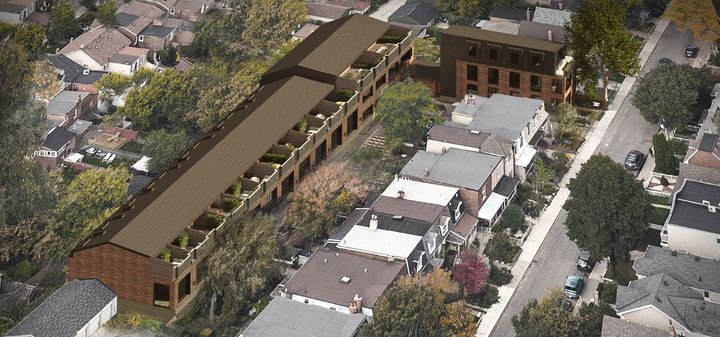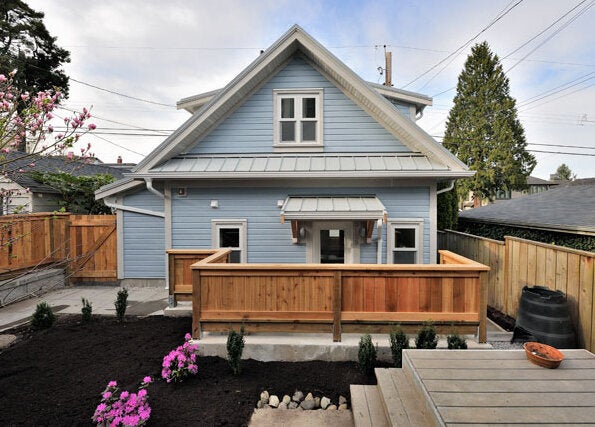TORONTO — Nine years ago, Thelma Fayle swapped her 4,000 square-foot home in a rural area of Victoria for a house measuring only nine feet wide on the inside.
Fayle had contracted a respiratory disease and was finding it exhausting to take care of her property, which contained a swimming pool and dozens of towering trees.
"I decided I didn't really want to spend the last third of my life rotely maintaining a huge house," says Fayle.
It takes Fayle a mere two hours to clean her "narrow home" from top to bottom, freeing her up for other activities such as reading, writing and volunteering.

Laneway homes in Toronto from Curated Properties. Niche buildings like this are providing more affordable housing for those who don't want to live in a condo tower.
The desire to save time is one of several factors cited by the growing number of Canadians who are turning to alternative styles of housing, ranging from narrow houses to tiny ones to those sandwiched into laneways between other homes.
Other factors include environmental considerations — smaller homes require less power to heat — and affordability concerns, as home prices in certain Canadian cities continue to soar out of reach for many.
In 2006, when a single-family home for half a million dollars was hard to come by in Victoria, Fayle snatched up her house for $275,000 — a paltry sum for a 1,000 square-foot space located less than three kilometres from the downtown of one the country's most desirable cities.
Toronto developer Adam Ochshorn says his company, Curated Properties, has found a niche in building homes for families who have been priced out of the market for detached houses but don't want to migrate out to the suburbs or live in a glass tower.
"We have people coming in and telling us that they have been looking to buy a home downtown for maybe a year or even two, but they keep losing what they want to buy in a bidding war," says Ochshorn.

A laneway home development from Curated Properties in Toronto.
Curated Properties has several projects in the works that preserve elements of the traditional detached house format — multi-floor living with an outdoor terrace — but in unconventional spaces and at a lower price point.
One of them, titled Dovercourt 455, consists of a dozen townhomes perched atop a two-storey office complex, each outfitted with two floors of living space and a rooftop terrace. Another is a conversion of an old yarn factory from the late 1800s that's situated in a laneway between two rows of houses.
Building homes in laneways can be challenging in many Canadian municipalities, due to various zoning restrictions.
Ochshorn says Toronto doesn't allow developers to dig up laneways, which are owned by the city, in order to bring water and sewage pipes to the project.
"The only reason that we were really allowed to develop this project into residential housing is because the property we bought included a house that connected us to the street and gave us a street address," he said.
That allows the company to dig up the portion that sits on private land in order to connect to the grid.
"There are so many of these lanes in great neighbourhoods that are being underutilized."
Experts say some of those restrictive policies are likely to loosen as cities like Toronto and Vancouver — facing a space and affordability crunch — look at ways of adding more unique types of housing.
"There are so many of these lanes in great neighbourhoods that are being underutilized," says Ochshorn.
For some, like Connor Ferster, alternative living is less about affordability and more about wanting to live off the grid.
In the winter of 2013 to 2014, Ferster, a former headhunter, ditched his studio apartment in downtown Calgary for a teepee 45 minutes outside the city. The following summer, with the help of family and friends, he built a 96-square foot home on wheels, which he lives in today.
'More meaningful life'
"I wanted to lead a more meaningful life, which meant being more engaged with the daily goings on," says Ferster.
"I need to think about where I'm getting my water from. I get to see the process of composting my own waste and having that go back into the earth."
Of course, the shift to compact living comes with some challenges.
Ottawa-based architect and tiny home expert Andy Thomson, who himself is sharing a 500 square-foot space with his wife and their 11-year-old child, says the key to getting by in a constrained space is to have "furniture that's like a swiss army knife" — such as shelving units and beds that fold into the walls.
Ferster, meanwhile, doesn't have a shower in his home, and visitors have to be comfortable using his composting toilet without any privacy.
"It feels very spacious, though, inside," he says.
Also on HuffPost:
